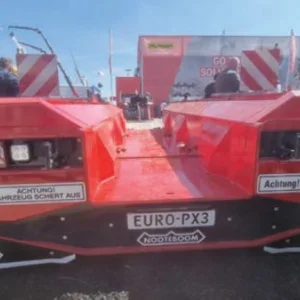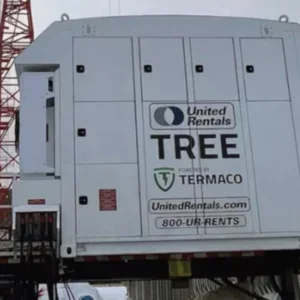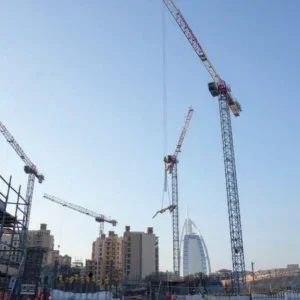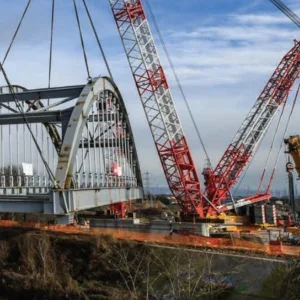In major markets around the world, crane owners and manufacturers are increasingly pushing for harmonised operator certification.
A harmonised approach makes it more likely all operators across a region will be trained to an acceptable standard, increasing safety both for site workers and the general public
Harmonisation also means that operators can work on machines across national or state borders. That both allows operators to migrate from markets where there is a shortage of work to those where demand for their skills is higher, and international companies, particularly those with the biggest, most highly specialised machines, to have their well trained operators travel with their cranes to jobsites outside their home market.
Klaus Meissner is president of the FEM mobile cranes group and convenor for the working group on the EN13000, and director of product intergrity for Terex. In this role, he sees the issue from both his employer’s perspective, and the broader viewpoint of the manufacturers represented in the EU standards group.
He says, "The products we are producing are used worldwide, and, at the heavier end, moved around the world. The operators are moving with the equipment and moving global. The key things that operators need to know, are pure physics. Is the same wherever you are in the wold: how do you calculate the tipping point, what is the structural strength of the crane. People need to know the physics. The more operators know, the better they work, the safer they are.
"There are still countries that don’t have any sort of formal certification. Then, of course, we have to make sure the content of certification is as much harmonised as possible."
Across Europe, two bodies are working to develop harmonised approaches to operator certification. ESTA, the Europe-wide association representing member state crane hirers and special transport firms is working on mobile crane operator certification. CECE, the construction equipment manufactuers’ association is working on a harmonised approach to operator and rigger certification.
The ESTA team is being led by Ton Klijn, managing director of Wagenborg Nedlift, and secretary of ESTA. Klijn says, "The problem is that every country had, a long time ago, started from their own point, in their own direction, and come up with their own forms of certification for operators. They haven’t evolved in the same direction, or produced the same result. Across the 28 EU member countries, there’s a few that don’t have anything. There are different levels at which you can be called an operator in different European countries. There are nine countries that have crane operators as a ‘recognised profession’.
"There are slight differences between those nine in qualification levels. Some have just crane operator, some make a distinction between mobile and fixed, some between telescopic and lattice boom. Portugal only recognises floating cranes.
"That’s an example of the second thing we should bear in mind. A lot of what has been devised, is not what is the right way to have the best possible operators, but a way to protect against foreign imports. We had a situation in Holland, where you had to have a TCVT certificate, but you could only take the examination in Dutch. I don’t think there are many German or French operators who speak Dutch. Luckily, the rules have changed now."
Peter Schiefer is CEO of Wolffkran and chairman of CECE’s tower cranes committee. He says, "This CECE committee is a two-fold committee, we have the CEO level group, and the working group, where representatives of the participating companies work out specific solutions. From time to time, we update and agree a common work programme. The main driver is always how we can make the crane word safer and better. The new EN 14439 norm [the EU standard for tower crane design] was a milestone for tower crane safety.
"After that, we thought, ‘What’s next?’. On crane technology we’re pretty well-covered with the EN norm, and through our liaison with the FEM. Technology-wise, we’d covered, not everything, but a lot, so far. We thought, what’s the next weak point in the tower crane industry. We all figured it was having a common, high standard, raising the bar in terms of operators and fitters. We’ll always go through the event stream: where are dangerous things happening, how can we avoid them in future?
"We came up with harmonised training. This was first articulated about two years ago, and then we started the working group on this. Various countries have some legislation in place, but it’s a blurry picture: there are licenses you need in France, not really much in Germany, some requirements in the UK. We agreed we should come up with one proposal of how we think drivers’ and fitters’ licenses should look. A quality level to one standard we should accomplish across Europe.
"We don’t want to impose any additional stress or burden on customers, but on the other hand, we firmly believe, the better people are trained and qualified, the fewer accidents will happen. It’s a difficult line in between. Most accidents happen because of lack of training, lack of being aware of some of the risks you get yourself into if you do something you don’t understand."
The best path to harmony
In the EU, with its mix of national and committee-wide standards and regulations, it can be difficult to find the best way to harmonise standards. It’s a challenge Meissner has had a lot of experience dealing with: "It’s a little difficult to see the right framework. Different member states have different systems, and health and safety issues are not harmonised. So it’s worth it to try every way to get operator certification recognised.
"It took NCCCO several years in the USA, and it’s still the situation that they cannot force it on a federal level. It’s still done by the states. It may end up being the same in Europe, where there is a legal framework in some member states, and then via that it is accepted on a mutual basis."
CECE and ESTA are planning on taking seperate routes to a harmonised system. Schiefer, speaking for CECE, says, "We want to go the route of going through the national bodies. We’re passing our request onto them. It’s then up to them to decide whether to regulate on a European level or not. We would recommend having a European directive. But it’s up to them.
"We pass it to them as a model, ask for their approval, but then they pass it on and move it forward. To go further, it will be the respective standards and safety bodies like the VDMA in Germany, who will pass it up to the national level."
Klijn’s group at ESTA wants to take a different approach. He says, "We’ve established an ESTA working group, made up of seven members from six EU countries, including industry representatives and those with skills in training operators. The group has finished a preliminary study of operator certification in the EU. We intend to take the route of recognised professions. We will establish a ‘common platform’, a term that comes from the system of recognised professions, and means the minimum required qualification, agreed upon by every country that recognises the profession. The nine who recognise crane operator as a profession, would have to agree to a minimum level of knowledge, skills and experience.
"One way is to go to all these governments, and get them behind you. That’s not a road I want to take, because I am afraid it will take forever to get done. The other way is to get an interested party, who represents a big industry, like oil and gas, to start it up. Once that’ s in place, the governments will take it up."
Graham Brent is executive director of the US NCCCO. His organisation, backed by trade group the SC&RA, took an approach similar to the one Klijn is proposing, getting major contractors on board with the certification programme first, then individual states, and finally having the programme recognised, alongside others, by OSHA and included in a proposed federal OSHA rule.
He says, "This has always been an industry driven initiative. It’s a risk management tool, a safety tool: we’d want to do this anyway, so this approach has been a good way to establish it. If we had tried to go to every state, and get them on the same page, we’d still be talking about it. You have to pick the channel that works.
The NCCCO approach has paid dividends not just in getting a programme upo and running, but by not being reliant on federal support. Right now, OSHA is proposing delaying a implementation of a federal rule while it looks at the contentious issue of whether operators should be certified by the capacity of crane they are allowed to work on, as well as by type.
Brent says, "From our side, we haven’t noticed any impact at all on certification levels. All the programmes have been put in place Our position is that this isn’t a compliance issue as much as a safety issue. There’s just as much reason to become trained and certified now as there ever was.
"From a safety point of view, there’s no need to wait on OSHA. We’ll see whether OSHA comes up with a requirement, but we’ve being certifying operators for 17 years. Those who are already certified, should be recertified.
"All four certification bodies have a formal written agreement from OSHA, recognising them to provide certification processes. However you’re doing it, with all four of us doing it slightly differently, that didn’t effect OSHA’s decision to recognise the programmes. So the delay isn’t relevant under the existing situation."
Grandfathers and trainees
A key element to any certification programme is finding a balance between recognising the established skills of experienced workers, and helping new workers find a career development path that suits their abilities and helps find them find the right job and level of training.
Meissner says, "It would make sense in the long term if you start as a rigger or slinger, and then start operating smaller, then bigger and more complex cranes, and then have the opportunity to train as a supervisor. So you can run through and get experience over time. Not having those systems in place though, means you have lots of operators already out in the field operating their cranes safely, but who have never been certified. So we also need a system that is open to all of those operators. We will have thousands who can already use their cranes safely. If a newby starts, it makes sense to start from the bottom level, but on the other hand we need a system that recognises people who are already operating safely."
Klijn is also a supporter of a tiered approach: "Once we have devised categories, we have to decide if an operator only need to know about operating cranes, or if they also need to know about rigging loads, slinging, etc. That is more like the Dutch system, where operators train first as a rigger or banksman. Personally, I think that’s the wise thing to do. Operators who get parachuted in who have only experience on cranes, don’t know what’s going on outside the crane.
"I’d propose a preliminary exam as a rigger, that you then work some time as a rigger, then qualify as a crane operator. That works well with the established EU system on qualifying a person, training them and qualifying them in new skills, and keeping those skills up to date. We’re initially focused on crane operators, but it is my firm belief we will come up with training including for banksman and riggers, That’s what happens at our company, Nedlift Wagenborg: new staff train as riggers, then the best of the riggers train as operator.
"The good news is, we now have a system in the EU so that the formal training of people on a technical level, is compatible between countries.
"I’ve always been great fan of English apprentice system, similar to the Dutch leerlingstelsel. Both countries have dropped that, and in craftsman-style professions, people with no formal training, lose out. The German’s have retained it with their AzuBi (aus zu Bildenen) system. You get someone out of school or technical college, they cost you some €200 a month, but they get technical experience. You get cheap work, they learn a trade. The hope is after one year, you can keep them."
Schiefer agrees too: "What we’re looking for is a licence, especially for the fitters, where you have different levels of qualification, where you have to pass and renew a test or license exam from time to time, to keep skills up-to-date. A staged approach, where we say, if you want to do this, you should have this licence, if you want to do more, you have to have a higher licence: to climb a crane will take a different skill level to just putting in the bolts."
Given that harmonisation of certification in the USA has taken decades, and is still not fully ready to be implemented, it may be some time before there are single schemes for workers on mobile cranes and tower cranes in Europe. Whether that comes via a customer-lead or regulator-backed system, or both, will depend on the success of CECE and ESTA’s approaches. However, it is clear that whatever happens, there is widespread industry support for EUwide schemes that allow for free, safe, movement of skilled labour and on-the-job training that allows workers to develop their abilites through their careers, demonstrating their abilities as they go.






